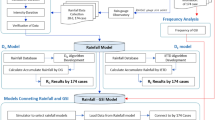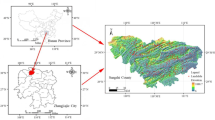Abstract
Rainfall-induced landslides are among the most widespread hazards in the world. Forecasting slope stability when rainfall events occur is an important topic in the landslide disaster field. The link between rainfall events and slope instability is uncertain, because of the variabile rainfall infiltration mechanism within a slope mass. To reduce this uncertainty, a dynamic Bayesian network (DBN) is utilised to analyse the stability of a slope in time domains by representing the probabilistic relationships of variables [rainfall intensity, cumulative infiltration, pore water pressure (PWP), and factor of safety] and relating these variables to each other over adjacent time steps. This model improves the accuracy of objective evaluation by coupling parts of observation value against the uncertainty. Successively, a deterministic method (DM) with empirical or tested values in models and a logistics regression (LR) method totally based on the statistical results are employed to estimate slope stability in time domains. Through comparing the temporal slope instability evaluation of the three mentioned methods with the real scenes of an artificial slope, the results demonstrate that 1) the DBN can evaluate the stability of a slope closer to reality in time domains compared to the DM; 2) The DBN estimates the instability of the slope in accordance with the LR method and can include some physical mechanisms. The characteristics of the DBN make the method a potential way to evaluate slope stability.














Similar content being viewed by others
References
Acharya G, De Smedt F, Long NT (2006) Assessing landslide hazard in GIS: a case study from Rasuwa, Nepal. Bull Eng Geol Env 65(1):99–107
Alvioli M, Guzzetti F, Rossi M (2014) Scaling properties of rainfall induced landslides predicted by a physically based model. Geomorphology 213(5):38–47
Ayalew L (1999) The effect of seasonal rainfall on landslides in the highlands of Ethiopia. Bull Eng Geol Env 58(1):9–19
Biondi G, Cascone E, Maugeri M, Motta E (2000) Seismic response of saturated cohesionless slopes. Soil Dyn Earthq Eng 20:209–215
Bogaard TA, Greco R (2016) Landslide hydrology: from hydrology to pore pressure. WIREs Water 3:439–459
Bonnard C, Tacher L, Beniston M (2008) Prediction of landslide movements caused by climate change: Modelling the behaviour of a mean elevation large slide in the Alps and assessing its uncertainties. Proc.10th Int. Symp. on Landslides and Engineered Slopes: 217–227
Borga M, Fontana GD, Cazorzi F (2002) Analysis of topographic and climatic control on rainfall-triggered shallow landsliding using a quasi-dynamic wetness index. J Hydrol 268:56–71
Casadei M, Dietrich WE, Miller NL (2003) Testing a model for predicting the timing and location of shallow landslide initiation in soil-mantled landscapes. Earth Surf Proc Land 28:925–950
Cascini L, Cuomo S, Guida D (2008) Typical source areas of May 1998 flow-like mass movements in the Campania region, southern Italy. Eng Geol 96:107–125
Chen YL, Uchimura T, Irfan M, Huang D, Xie JR (2017) Detection of water infiltration and deformation of unsaturated soils by elastic wave velocity. Landslides 14(5):1715–1730
Chowdhury RN, Xu DW (1993) Rational polynomial technique in slope stability analysis. Journal of Geotechnical Engineering Division, ASCE 119(12):1910–1928
Claessens L, Knapen A, Kitutu MG, Poesen J, Deckers JA (2007) Modelling landslide hazard, soil redistribution and sediment yield of landslides on the Ugandan footslopes of mount Elgon. Geomorphology 90(1):23–35
Collins BD, Znidarcic D (2004) Stability analyses of rainfall induced landslides. J Geotech Geoenviron 130(4):362–372
Corominas J, Moya J (1999) Reconstructing recent landslide activity in relation to rainfall in the Llobregat River basin, eastern Pyrenees, Spain. Geomorphology 30:79–93
Crosta G (1998) Regionalization of rainfall thresholds: an aid to landslide hazard evaluation. Environ Geol 35:131–145
D’Aniello A, Cozzolino L, Cimorelli L, Covelli C, Della Morte R, Pianese D (2014) One-dimensional simulation of debris-flow inception and propagation. Third Italian workshop on landslides. Procedia earth. Planet Sci 9:112–121. https://doi.org/10.1016/j.proeps.2014.06.005.
Dai Y, Fredlund DG, Stolte WJ (1993) A probabilistic slope stability analysis using deterministic computer software. Proceedings of the Conference on Probabilistic Methods in Geotechnical Engineering, Canbera, Australia, February 10-12:267–274
De Vita P, Napolitano E, Godt JW, Baum RL (2013) Deterministic estimation of hydrological thresholds for shallow landslide initiation and slope stability models: case study from the Somma-Vesuvius area of southern Italy. Landslides 10(6):713–728
Duncan JM (2000) Factors of safety and reliability in geotechnical engineering. J Geotech Geoenviron Eng ASCE 126(4):307–316
Furman A, Warrick AW, Zerihun D, Sanchez CA (2006) Modified Kostiakov infiltration function: accounting for initial and boundary conditions. J Irrig Drain Eng 132:587–596
Geo-slope International Ltd (2007) Seep/W User's guide for finite element seepage analysis. GEO-SLOPE International Ltd., Calgary, Alberta, Canada
Godt JW (2004) Observed and modeled rainfall conditions for shallow landsliding in the Seattle, Washington, area. PhD thesis. University of Colorado, Boulder
Guzzetti F, Peruccacci S, Rossi M, Stark CP (2007) Rainfall thresholds for the initiation of landslides in central and southern Europe. Meteorog Atmos Phys 98:239–267
Guzzetti F, Peruccacci S, Rossi M, Stark CP (2008) The rainfall intensity–duration control of shallow landslides and debris flows: an update. Landslides 5(1):3–17
Hamby DM (1994) A review of techniques for parameter sensitivity analysis of environmental models. Environ Monit Assess 32(2):135–154
Hapke C, Plant N (2010) Predicting coastal cliff erosion using a Bayesian probabilistic model. Mar Geol 278:140–149
Ismail EH, Rogers JD, Ahmed MF, Usery EL, Abdelsalam MG (2017) Landslide susceptibility mapping of blue nile and tekeze river basins using oblique rainfall-aspect rasters. Bull Eng Geol Env (online)
Iverson RM (2000) Landslide triggering by rain infiltration. Water Resour Res 36(7):1897–1910
Li AG, Tham LG, Yue GQ, Lee CF, Law KT (2005) Comparison of field and laboratory soil–water characteristic curves. J Geotech Geoenviron 131(9):1176–1180
Lora M, Camporese M, Salandin P (2016) Design and performance of a nozzle-type rainfall simulator for landslide triggering experiments. Catena 140:77–89
Michiue M (1985) A method for predicting slope failures on cliff and mountain due to heavy rain. Natural Disaster Science 7(1):1–12
Montgomery DR, Dietrich WE (1994) A physically based model for the topographic control on shallow landsliding. Water Resour Res 30(4):1153–1171
Murphy KP (2002) Dynamic Bayesian networks: representation, inference and learning. PhD thesis. University of California, Berkeley
Ohtsu H, Ohnish Y, Takahashi K (2003) A study on the slope risk evaluation due to rainfall using the simplified storage tank model. Proceeding of the 2nd Southeast Asia Workshop on Rock Engineering, Bangkok, Thailand: 67–72
Pack RT, Tarboton DG, Goodwin CN (2001) Assessing terrain stability in a GIS using SINMAP. 15th annual GIS conference, Vancouver, British Columbia, February 19–22
Rahardjo H, Nio AS, Leong EC, Song NY (2010) Effects of groundwater table position and soil properties on stability of slope during rainfall. J Geotech Geoenviron 136(11):1555–1564
Reid ME (1994) A pore-pressure diffusion model for estimating landslide-inducing rainfall. J Geol 102(6):709–717
Rosi A, Segoni S, Catani F, Casagli N (2012) Statistical and environmental analyses for the definition of a regional rainfall threshold system for landslide triggering in Tuscany (Italy). J Geogr Sci 22(4):617–629
Schaap MG, Van Genuchten MT (2006) A modified Mualem–van Genuchten formulation for improved description of the hydraulic conductivity near saturation. Vadose Zone J 5(1):27–34
Takahashi K (2004) Research of underground water numerical analysis method that considering water cycle system. PhD thesis. Kyoto University, Japan
Tricker AS (1978) The infiltration cylinder: some comments on its use. J Hydrol 36(3):383–391
Tsai TL, Tsai PY, Yang PJ (2015) Probabilistic modeling of rainfall-induced shallow landslide using a point-estimate method. Environ Earth Sci 73(8):4109–4117
Walker SH, Duncan DB (1967) Estimation of the probability of an event as a function of several independent variables. Biometrika 54:167–179
Wang G, Sassa K (2003) Pore-pressure generation and movement of rainfall-induced landslides: effects of grain size and fine-particle content. Eng Geol 69:109–125
Yang X, You X (2013) Estimating parameters of van Genuchten model for soil water retention curve by intelligent algorithms. Appl Math Inform Sci 7(5):1977–1983
Zhang QG, Huang RQ, Liu YX, XP S, Li GQ, Nie W (2016) A physically-based geometry model for transport distance estimation of rainfall-eroded soil sediment. Appl Sci 6:34
Acknowledgements
We appreciate the support from the Opening Fund of State Key Laboratory of Geo-hazard Prevention and Geo-environment Protection (Chengdu University of Technology)-SKLGP2017K006, and the China Postdoctoral Science Foundation-2017M620048 the suggestions from Dr. Miloš Marjanović (University of Belgrade, Belgrade, Chair of Geotechnics).
Author information
Authors and Affiliations
Corresponding author
Rights and permissions
About this article
Cite this article
Nie, W., Feng, D., Lohpaisankrit, W. et al. A dynamic Bayesian network-based model for evaluating rainfall-induced landslides. Bull Eng Geol Environ 78, 2069–2080 (2019). https://doi.org/10.1007/s10064-017-1221-2
Received:
Accepted:
Published:
Issue Date:
DOI: https://doi.org/10.1007/s10064-017-1221-2




